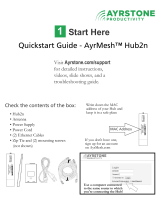Adding a hub to the Ajax app
After adding a hub to your account, you become the administrator of the device.
Administrators can invite other users to the security system and determine their
rights. Hub 2 Plus central unit can have up to 200 users.
Changing or removing the administrator does not reset the settings of the hub
or connected devices.
connect to the Internet. The green or white logo color indicates that the hub
is running and connected to Ajax Cloud.
If the Ethernet connection is not established automatically, disable proxy and MAC
address ltration and activate DHCP in the router settings. The hub will
automatically receive an IP address. After that, you will be able to set up a static IP
address of the hub in the Ajax app.
4. To connect to the cellular network, you need a micro SIM card with a
disabled PIN code request (you can disable it using a mobile phone) and a
sucient amount on your account to pay for the services at your operator’s
rates. If the hub does not connect to the cellular network, use Ethernet to
congure the network parameters: roaming, APN access point, username,
and password. Contact your telecom operator for support to nd out these
options.
1. Turn on the hub and wait until the logo lights up green or white.
2. Open the Ajax app. Give access to the requested system functions to fully use the capabilities of
the Ajax app and not to miss alerts about alarms or events.
How to set up notications on iOS
How to set up notications on Android
3. Open the Add hub menu Select the way of registering: manually or step-by-step guidance. If you
are setting the system up for the rst time, use step-by-step guidance.
4. Specify the name of the hub and scan the QR code located under the SmartBracket mounting
panel or enter it manually.
5. Wait until the hub is added. The linked hub will be displayed in the Devices tab .





















